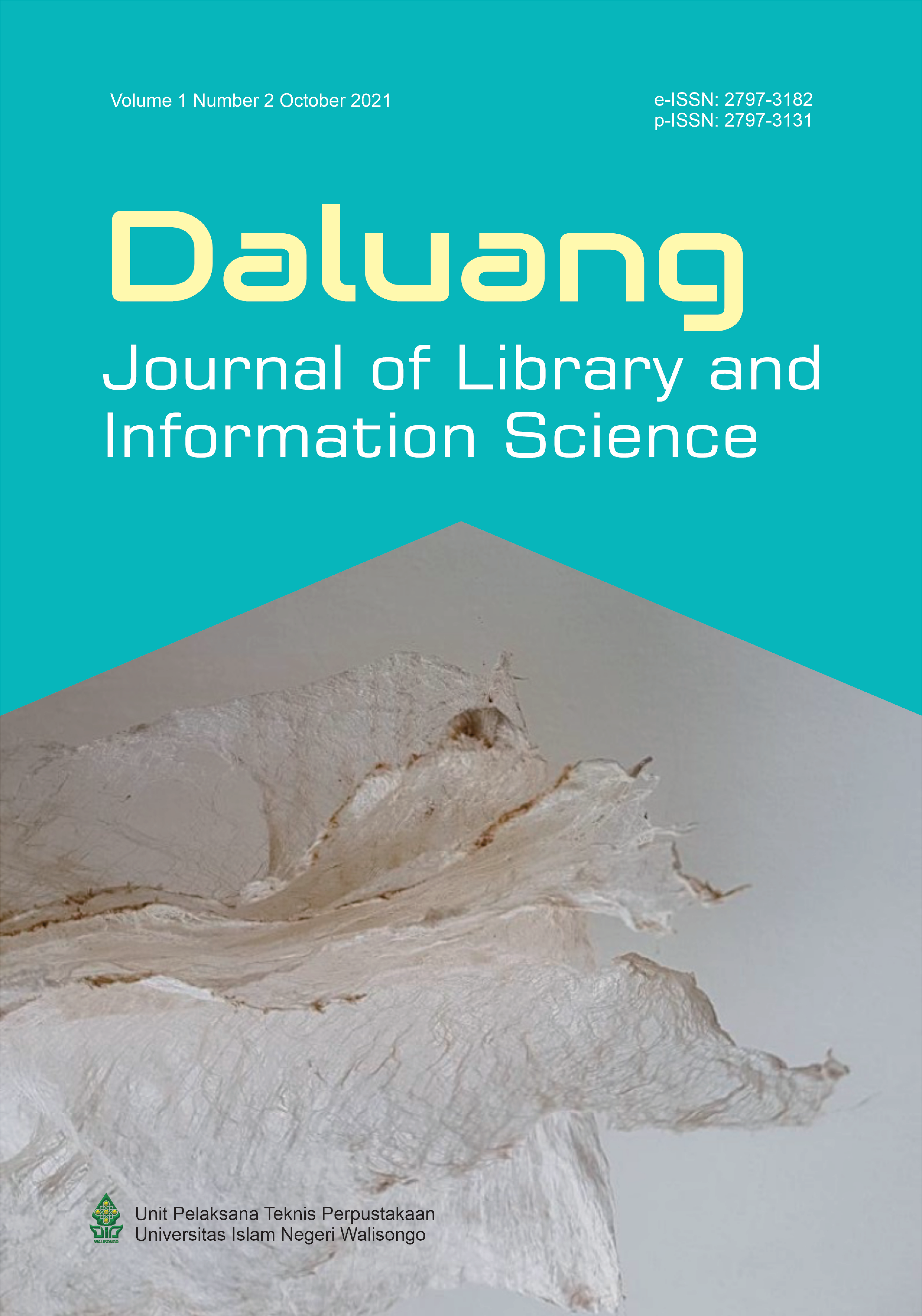Pelestarian Koleksi Langka Berbasis Flipbook di Perpustakaan Umum
Main Article Content
Abstract
Introduction. Currently, the office limits access to collections of rare books for users to preserve the physical collection. Users who want to access the display will only get a synopsis. However, this policy makes users challenging to access the full-text content. The collection of rare books has also not received proper preservation and creates some rare book collections to be damaged. This study aims to determine the process of digitizing the rare book collections at the Archives and Library Office of Banjarnegara Regency based on Flipbook.
Methodology. This study is a qualitative descriptive study. The selection of informants in this study is a purposive sampling technique. The data collection in this study is observation, interview, and literature study.
Result and discussion. This study shows that digitizing the rare book collections includes selection, scanning, editing, flipbook making, and uploading on the OPAC INLISLite application 3.1. Users can access rare book collections in the form of flipbooks or interesting digital books. The obstacles found in digitizing rare book collections are the absence of SOPs of digitizing, inadequate digitization facilities and infrastructures, the absence of Human Resources (HR). Nevertheless, they master the digitization of collections and the lack of budget allocations for digitizing the collection.
Conclusion. The impact of digitization with Flipbook is that users have full access to a collection of rare books needed by users and become an alternative to the preservation and empowerment of libraries and users that are more attractive and safe
Downloads
Article Details
This work is licensed under a Creative Commons Attribution-NonCommercial-NoDerivatives 4.0 International License.
Articles published in Daluang Journal of Library and information Science are available under Creative Commons Attribution Non-Commercial No Derivatives Licence (CC BY-NC-ND 4.0). Authors retain copyright in their work and grant Daluang Journal of Library and information Science right of first publication under CC BY-NC-ND 4.0. Users have the right to read, download, copy, distribute, print, search, or link to the full texts of articles in this journal, and to use them for any other lawful purpose.
Articles published in Daluang Journal of Library and information Science can be copied, communicated and shared in their published form for non-commercial purposes provided full attribution is given to the author and the journal. Authors are able to enter into separate, additional contractual arrangements for the non-exclusive distribution of the journal's published version of the work (e.g., post it to an institutional repository or publish it in a book), with an acknowledgment of its initial publication in this journal.
This copyright notice applies to articles published in Daluang Journal of Library and information Science volumes 1 onwards.
References
Andina, E. (2011). BUKU DIGITAL DAN PENGATURANNYA. Aspirasi: Jurnal Masalah-masalah Sosial, 2(1), 79–95. https://doi.org/10.46807/ASPIRASI.V2I1.429
Asaniyah, N. (2017). Pelestarian Informasi Koleksi Langka. Digitalisasi, Restorasi, Fumigasi. Buletin Perpustakaan. Buletin Perpustakaan, 57(Juni), 85–94.
Departemen Pendidikan Nasional. (2014). Kamus Besar Bahasa Indonesia. Balai Pustaka.
Fadhlullah, M. F., & Christiani, L. (2019). Analisis Kegiatan Alih Media Digital Sebagai Upaya Pelestarian Koleksi Local Content Di UPT Perpustakaan Proklamator Bung Hatta. Jurnal Ilmu Perpustakaan, 6(3), 681–690.
Hs., L. (2009). Manajemen Perpustakaan. Pinus.
Martoatmodjo, K. (2013). Pelestarian Bahan Pustaka. Universitas Terbuka.
Perpustakaan Nasional RI. (2014). Pedoman Pembuatan E-Book dan Standar Alih Media.
Perpustakaan Nasional RI. (2019). Peraturan Perpustakaan Nasional Republik Indonesia Nomor 2 Tahun 2019.
Prabowo, A., & Heriyanto. (2013). Analisis Pemanfaatan Buku Elektronik ( E-Book ) Oleh Pemustaka di Perpustakaan SMA Negeri 1 Semarang. Jurnal Ilmu Perpustakaan, 2, 1–9.
Putranto, M. T. D., & Husna, J. (2015). “Proses Digitalisasi Koleksi Deposit Di UPT Perpustakaan Daerah Jawa Tengah.” Ilmu Perpustakaan, 4(3), 2. https://ejournal3.undip.ac.id/index.php/jip/article/view/9736
Undang-Undang Republik Indonesia No 28 Tahun 2014 tentang Hak Cipta, Pub. L. No. 28 (2014). https://peraturan.bpk.go.id/Home/Details/38690
Riyanto, Lukman, & Subagyo. (2012). Pengembangan digital library local contentpekalongan dalam format buku 3 dimensi. Jurnal LIPI, 1(1), 1–13.
Saleh, A. R. (2013). Pengembangan Perpustakaan Digital (2 ed.). Rumah Q-ta Production. https://www.researchgate.net/profile/Abdul-Saleh/publication/303805197_Pengembangan_perpustakaan_digital_teori_dan_praktik_tahap_demi_tahap/links/5753bdbe08ae17e65ec6d325/Pengembangan-perpustakaan-digital-teori-dan-praktik-tahap-demi-tahap.pdf
Sugianto, D., Abdullah, A. G., Elvyanti, S., & Muladi, Y. (2013). Modul Virtual: Multimedia Flip Book Dasar Teknik Digital. Jurnal INVOTEC, 6, 101–116.
Sulistyo-Basuki. (2006). Metode Penelitian. Wedatama Widya Sastra.
Sulistyo-Basuki. (1991). Pengantar ilmu perpustakaan. In Gramedia Pustaka Utama. Gramedia Pustaka Utama. https://doi.org/10.1145/3132847.3132886
Surachman, A. (2007). Membangun Koleksi Digital.
Susilana, R., & Riyana, C. (2008). Media Pembelajaran: Hakikat, Pengembangan, Pemanfaatan, dan Penilaian. Wacana Prima.
Ulandari, Ariyati, E., & Titin. (2018). Pengaruh Flash Flipbook terhadap Hasil Belajar Siswa di SMP Negeri 11 Pontianak. Jurnal Pendidikan Dan Pembelajaran Khatulistiwa, 7(12), 1–10.



